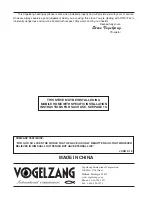
Page 12 / TR007 PONDEROSA™
Vogelzang International Corp.
VGZ-031 / 20120619.1
Figure 12 - Chimney Construction through Roof
Figure 13 - Chimney Connection to Firebox
through Masonry Wall
CHIMNEY CONNECTIONS continued …
MANUFACTURED CHIMNEY
REFER TO CHIMNEY AND CHIMNEY CONNEC-
TOR MAKER’S INSTRUCTIONS FOR INSTALLATION
AND USE.
Use only 6˝/152mm diameter manufactured chim-
ney system listed to UL 103 HT (US) or ULC-S629
(CDN). Chimney made to this listing is High Tempera-
ture rated to 2100°F/1149°C. Use chimney from only
one manufacturer. Never mix brands. Carefully follow
the chimney manufacturer’s stated requirements and
clearances. Use the chimney manufacturer’s attic
guards, roof supports, flashing and fire stops when
passing through a ceiling. Use a listed wall pass-thru
when passing through a combustible wall. Do not use
makeshift compromises during installation.
WARNING: DO NOT USE A SINGLE-WALL CON-
NECTION PIPE AS A CHIMNEY!
When using a pre-existing chimney, have its condi-
tion and installation inspected before using. Make sure
that the chimney meets all of the UL rating requirements
listed above. Be aware that not all manufactured chim-
ney is UL 103 HT/ULC-S629 rated.
NOTE: It is recommended that you contact a
licensed heating and cooling contractor (consult your
local yellow pages) for chimney installation.
Manufactured chimney with the proper required
UL/ULC listing is available from most home centers,
hardware stores, and HVAC supply stores.
You may wish to view chimney manufactur-
ers’ information on-line. See, www.duravent.com,
www.selkirkinc.com or www.mtlfab.com.
VENTING TO EXISTING FIREPLACE
In some instances, people desire to convert an
existing fireplace for stove use. Usually, safe connec-
tion to an existing masonry chimney requires more
work than using a prefabricated chimney. The existing
fireplace must be closed and sealed at the damper with
high-temperature caulk, ceramic wool, or furnace ce-
ment. Prior to installation, clean and inspect the existing
flue and smoke shelf. Installation should be designed
so the system can be dismantled for periodic cleaning
and inspection.
Before conversion, make sure the
existing chimney is structurally sound, the chim-
ney incorporates a flue liner and make sure it is in
good condition. (A flue liner consists of clay tile that
protects the brickwork of a chimney. If a chimney does
not have a liner, or it is damaged, have it relined by a
professional.
Do Not use a chimney that is unlined
or damaged!) If you have any question regarding the
condition of the chimney, consult a qualified licensed
contractor, qualified engineer, competent mason, cer-
continued on next page
Chimney Minimum Height Requirements:
(1) Overall Height – 15 ft./4.6m min.
(2) Height above roof – 3 ft./91cm
(3) Height above slope – 2 ft./61cm min. within
10 ft./3.05m
(4) Minimum rise before horiz. section – 24 in./61cm
NOTICE: If minimum chimney requirements are
not met, your stove will not operate properly.












































